Andrew Cartmel's Blog, page 20
July 9, 2017
Wonder Woman by Allan Heinberg
 DC Comics haven't had a lot of luck in terms of their movie adaptations. Certainly Christopher Nolan's Batman franchise has been a hit, but elsewhere the results have been somewhat dire.
DC Comics haven't had a lot of luck in terms of their movie adaptations. Certainly Christopher Nolan's Batman franchise has been a hit, but elsewhere the results have been somewhat dire. Zack Snyder's recent Superman (and now Batman) movies are, I think, numbingly poor. As was Suicide Squad from the normally excellent David Ayer. And then there's Green Lantern...
So my hopes were low for the new Wonder Woman movie. How wrong I was. It's an absolutely delightful popcorn picture, and also one of the best films of the year.
It gets off to a rocky start with a long, long, long prologue on Paradise Island, the enclave of Amazons where Diana (Gal Gadot) grows up. We ploddingly establish the set up for the film — basically that there's a bad guy called Ares, who will turn up later in a rather obvious twist.
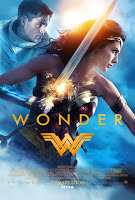 But as soon as plucky pilot Steve Trevor (Chris Pine) turns up, and Wonder Woman is precipitated into the real world, the movie hits its stride and never puts a foot wrong.
But as soon as plucky pilot Steve Trevor (Chris Pine) turns up, and Wonder Woman is precipitated into the real world, the movie hits its stride and never puts a foot wrong.The smartest decision by the writers was making Wonder Woman a period piece. Perhaps because of their inherent silliness, comic book stories work vastly better at a remove from the modern day world.
Crucially, though, unlike the World War Two setting of, say Captain America — which presented a ludicrous fantasy of a racially integrated US Army — Wonder Woman takes pains to actually try and depict the real horror and suffer of its own period — World War One.
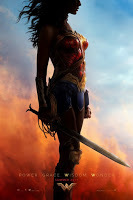 When Diana sees the casualties of the mass slaughter she registers horror, and so does the audience.
When Diana sees the casualties of the mass slaughter she registers horror, and so does the audience. Gal Gadot is absolutely radiant in the lead role, playing the part with real heart and humour — "A baby!" she exclaims in London (you don't have such things back on the island) and has to be dissuaded from racing over to inspect the kid.
But that heart and humour were put there in the script. The screenplay is by Allan Heinberg (who has a distinguished track record in television, including Scandal) developed from earlier drafts by Jason Fuchs and, of all people, Zack Snyder.
 (One doesn't expect heart or humour from Zack Snyder.) The movie is splendidly directed by Patty Jenkins, best known for Monster (2003).
(One doesn't expect heart or humour from Zack Snyder.) The movie is splendidly directed by Patty Jenkins, best known for Monster (2003).Wonder Woman has some terrific actions sequences (and a rather dull final battle). But for me the real pleasures were the small moments of fun, and some surprising character development.
Among the ragtag band of good guys who join Diana on her quest is an American Indian, called simply the Chief (played by Canadian actor Eugene Brave Rock).
 Diana, who of course knows nothing of our world, has a late night camp fire chat with the Chief about his history, and he tells how his ancestors lost everything. "Who took that from your people?" she asks.
Diana, who of course knows nothing of our world, has a late night camp fire chat with the Chief about his history, and he tells how his ancestors lost everything. "Who took that from your people?" she asks."His people," says the Chief tersely, nodding at the sleeping Chris Pine.
Wonder Woman is a fun movie, a classic, a wonderful blend of reality and fantasy and better than it has any right to be. If you only see one summer blockbuster, I urge you to make it this one.
(Image credits: Plenty of posters at Imp Awards.)
Published on July 09, 2017 01:58
July 2, 2017
Border Town Girl by John D. MacDonald
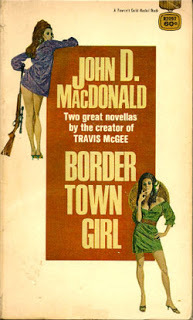 Before John D. MacDonald embarked on his distinguished career as a novelist he learned his trade writing short fiction for magazines, both pulp magazines and slicks. Most of these shorter efforts have been consigned to oblivion, but Border Town Girl is fascinating because it preserves two of the longer examples — what we'd call novellas.
Before John D. MacDonald embarked on his distinguished career as a novelist he learned his trade writing short fiction for magazines, both pulp magazines and slicks. Most of these shorter efforts have been consigned to oblivion, but Border Town Girl is fascinating because it preserves two of the longer examples — what we'd call novellas.The pair of stories are of roughly equal length and are called Border Town Girl (great title) and Linda (dull title). They were published in 1950 and 1956, the title story originally appearing in Dime Detective Magazine as 'Five Star Fugitive' (lame title), a pulp if there ever was one, and Linda making its debut in this book, although it would later be reprinted in a magazine hilariously entitled Climax.
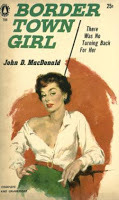 The long gap between the writing of the stories shows. Border Town Girl is about a disillusioned writer and war vet (a classic MacDonald protagonist) called Lane Sanson who gets caught up in drug smuggling from Mexico to Texas.
The long gap between the writing of the stories shows. Border Town Girl is about a disillusioned writer and war vet (a classic MacDonald protagonist) called Lane Sanson who gets caught up in drug smuggling from Mexico to Texas. It's an efficient and vivid tale, but it is chiefly notable for its villain, Christy, a great name — deceptively innocent sounding — for a memorable bad guy with frightening strength and "zany little blue eyes."
There is a hellish, nightmarish sequence when the wounded, fever-ridden Christy stumbles towards his revenge — and his demise.
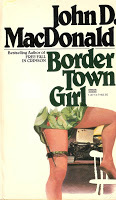 The story features some dud dialogue like "You're a strange man, Lane Sanson", but on the other hand there are some fine descriptions — "He drifted, soundless as smoke, across the room..." "The sun was a hot weight behind him, pushing him along."
The story features some dud dialogue like "You're a strange man, Lane Sanson", but on the other hand there are some fine descriptions — "He drifted, soundless as smoke, across the room..." "The sun was a hot weight behind him, pushing him along." And this wonderful evocation of an airliner, a "tired old plane" which "had sagged and blundered its way through storm and hail." The plane itself is virtually irrelevant to the story, but MacDonald just can't help being an outstanding writer.
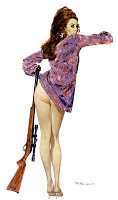
Despite it's anodyne title Linda, written six years later, is a masterpiece. It tells of a dull little man, a "desperado of the cellar workshop," who has somehow managed to marry a gorgeous siren. "Linda was flamboyantly noticeable." Whereas their friend Stella's appeal is "subtle in the way that a Japanese print is subtle."
Poor Stella is going to be murdered by Linda and her own husband, and they are going to frame Linda's husband, the dull little man, for the killing. I could hardly bear to go on reading as the jaws of fate closed savagely on our hero...
 The carefully planned murder takes place when the two couples go on holiday to Florida in rented cabins beside the beach. As usual, MacDonald brings the setting wonderfully to life: "Small sandpipers ran in flocks, pecking and then trotting up and away from the lap of waves, like groups of spry, stooped little men in tailcoats with their hands locked behind them."
The carefully planned murder takes place when the two couples go on holiday to Florida in rented cabins beside the beach. As usual, MacDonald brings the setting wonderfully to life: "Small sandpipers ran in flocks, pecking and then trotting up and away from the lap of waves, like groups of spry, stooped little men in tailcoats with their hands locked behind them."The killing of Stella is horrific, as is the apparently full-proof framing of our hero. But, incredibly and satisfyingly, the tables are turned and Linda becomes "a shrewd animal fighting for its life."
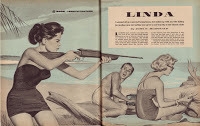 This is an explosive, harrowing and unforgettable tale. No wonder it was twice filmed for television.
This is an explosive, harrowing and unforgettable tale. No wonder it was twice filmed for television. (Image credits: The covers are from Good Reads, except for the garter-and-typewriter which is from Pinterest. The magazine illustration for Linda is from the superb and informative MacDonald blog The Trap of Solid Gold. The original McGinnis illustrations — including the rather more cheeky one — are from Elisa Rolle's McGinnis blog. )
Published on July 02, 2017 02:00
June 25, 2017
4DX Cinema: The Tingler Returns
 For most of last year my local cinema in south London was in a state of chaos, being ripped apart and undergoing extensive renovations. While part of this project was to generally upgrade the screens and seating — a good thing — another major objective was to install a new 4DX screen.
For most of last year my local cinema in south London was in a state of chaos, being ripped apart and undergoing extensive renovations. While part of this project was to generally upgrade the screens and seating — a good thing — another major objective was to install a new 4DX screen."What the hell is 4DX?" I hear you ask. Well, when I described it to a buddy of mine he laughed and said "It's The Tingler!" Which was hilarious, because that had been exactly my own reaction. The Tingler was a low budget 1959 horror movie by a huckster of a producer named William Castle. To promote it, Castle dreamed up a contrivance called Percepto. This involved having seats in the cinema wired so they would vibrate at a certain point in the movie. It was a cheap and silly gimmick.
4DX also makes your seat vibrate. And it does more than that, but allow me to quote from the publicity blurb:
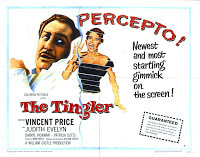 "Providing a revolutionary cinematic experience which stimulates all five senses, the 4DX includes high-tech motion seats and special effects including wind, fog, lightning, bubbles, water, rain and scents, in both 2D and 3D formats. These effects work in perfect synchronicity with the action on screen – creating the most unmissable and exhilarating cinematic experience yet."
"Providing a revolutionary cinematic experience which stimulates all five senses, the 4DX includes high-tech motion seats and special effects including wind, fog, lightning, bubbles, water, rain and scents, in both 2D and 3D formats. These effects work in perfect synchronicity with the action on screen – creating the most unmissable and exhilarating cinematic experience yet." Friends... it is just another cheap and silly gimmick. Though it's not cheap in terms of admission prices — a full-price adult ticket is around £20. Even so, I was tempted to check out this unmissable and exhilarating cinematic experience. So as soon as the 4DX screen opened, I tried to see Rogue One there. Unfortunately, the 4DX system had broken down, as it did frequently in the first few weeks.
 But I have finally caught a movie in 4DX — Wonder Woman — and I can describe what it's like. (I will write about the Wonder Woman film itself in a separate post.)
But I have finally caught a movie in 4DX — Wonder Woman — and I can describe what it's like. (I will write about the Wonder Woman film itself in a separate post.)First, it has to be said that the 4DX seats are big and comfy. But soon they are in constant motion. For instance, when we see the Amazons on horseback, our seats jog us as if we're riding a horse.
Now, this might make sense if it was a point-of-view shot of somebody who is riding a horse. To put you into the skin of the rider, so to speak. But it makes no sense at all if you have a long shot of somebody riding a horse in the distance.
 Similarly, in a fight scene, as the good guys and bad guys punch each other, our seats jerk around and we get jabbed in the back — the effect is a bit like a massage chair gone rogue.
Similarly, in a fight scene, as the good guys and bad guys punch each other, our seats jerk around and we get jabbed in the back — the effect is a bit like a massage chair gone rogue. But why, when the bad guy hits the ground, do we feel an impact? Are we supposed to be the bad guy?
This confusion about viewpoint is one of the fatal flaws of the system. But there are plenty more. When a strong wind starts blowing in a scene, a big wind machine starts up in the cinema — making a hell of a racket and ruining our enjoyment.
And then there are the puffs of air. In the back of your seat, on either side of your head, are two small holes. These emit violent and noisy blasts of cold air onto your face to — supposedly — mimic the feel of a near miss as a bullet or an arrow whizzes past to you.
 It's difficult to describe how annoying this is. I was soon dreading any gunfight or use of the bow and arrow. I ended up trying to stick wads of Kleenex into the goddamned holes to block them (it wasn't very effective).
It's difficult to describe how annoying this is. I was soon dreading any gunfight or use of the bow and arrow. I ended up trying to stick wads of Kleenex into the goddamned holes to block them (it wasn't very effective).There are controls on the arms of your chair, but unfortunately these only allow you to turn off one option — the drop of water in the face. A good idea, for those of us who don't want to contract Legionaire's disease. But it did nothing to stop the goddamned puffs of air.
4DX is a waste of time and I can't believe it will ever catch on. It won't save a bad movie but it will certainly spoil a good one. Luckily Wonder Woman was sufficiently excellent to survive the 4DX treatment, but many other movies wouldn't be.

I recommend avoiding the 4DX experience, but if you do go you might find yourself sorely tempted to use some chewing gum to block those bloody air puffs.
(Image credits: The Tingler poster is from Texas Public Radio. The ecstatic people wearing 3D glasses and looking suspiciously like audience shills in a publicity shot are from the Wandsworth Guardian. The other awed audience members are from this Cineworld page. The man enjoying his flaming seat is from another Cineword page. The pictures of the 4DX seats are from Hey Guys. Gal Gadot as Wonder Woman — and she is great — is from Cosmic Book News.)
Published on June 25, 2017 02:00
June 18, 2017
The Mummy by Kurtzman, Koepp, McQuarrie
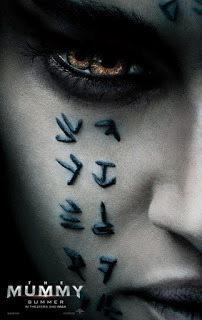 To say that I wasn't a fan of the previous (highly successful) Mummy franchise, created by writer-director Stephen Sommers, would be to put it mildly.
To say that I wasn't a fan of the previous (highly successful) Mummy franchise, created by writer-director Stephen Sommers, would be to put it mildly. Brendan Fraser and Rachel Weiss were terrific, but the movies themselves were junk. Overblown, incoherent, with no narrative armature or emotional core.
They dumped a ton of CGI on the audience instead of bothering with niceties like empathy or story or characterisation.
So it's sad to report that the new reboot of the series falls into exactly the same trap. And it really didn't need to. The cast is even stronger this time, and the movie begins really well...
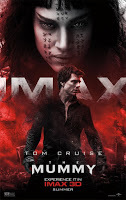
Nick (Tom Cruise) and Chris (Jake Johnson) are theoretically attached to the US Army in Iraq, but basically they're there to loot antiquities.
Beautiful archaeologist Jenny (Annabelle Wallis, from Peaky Blinders) has a map of unique treasure site, given her to by the mysterious and powerful Henry (Russell Crowe).
Nick and Chris steal the map and are the first to arrive at the site. And given the title of the movie, there's no prizes for guessing what they find there...
This whole section of the movie is very effective and culminates in Nick, Chris and Jenny flying back with a sarcophagus in a military transport plane, which breaks apart over England in a scene which — while far from original — is thrilling fun.
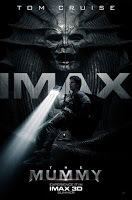
The rest of the movie takes place in England, and mostly in London. If the plane crash was reminiscent of Monster Squad, much else — such as the running gag of Nick's now dead friend Chris popping up all over the place — calls to mind An American Werewolf in London.
On the other hand, the Mummy (played by the striking Sofia Boutella, who was so great in Kingsman and Star Trek Beyond) has the power to summon masses of rats and other vermin in a manner which is reminiscent of Dracula.
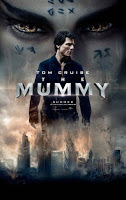 This actually makes a lot of sense, when you consider the true, uncredited, source of all the Mummy movies is probably Dracula's creator, Bram Stoker, in the shape of his novel The Jewel of Seven Stars.
This actually makes a lot of sense, when you consider the true, uncredited, source of all the Mummy movies is probably Dracula's creator, Bram Stoker, in the shape of his novel The Jewel of Seven Stars.But where The Mummy goes fatally off the rails is when it drags in the work of another great Victorian Gothic novelist. Because the 'Henry' whom Russell Crowe portrays turns out to be Dr Henry Jeckyll — yes, that's right, as in Dr Jeckyll and Mr Hyde.
This just makes no sense at all. It's a wild lurch into the territory of The League of Extraordinary Gentlemen or Penny Dreadful, but the movie doesn't pull it off, and never recovers from it. The descent into boring, silly and meaningless action is precipitous and irreversible.
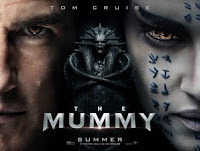
The characters, and the audience, are soon buried under a numbing avalanche of dull CGI.
What a pity. This was so nearly a really good summer popcorn movie.
(Image credits: All the posters are from good old reliable old Imp Awards.)
Published on June 18, 2017 02:00
June 11, 2017
Unlocked by Peter O'Brien
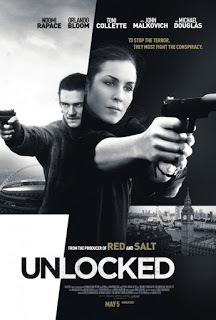 I love a good thriller, and this is a great thriller. It is set in London, and concerns an American agent who is forced to go rogue because she is menaced from all sides and doesn't know who to trust.
I love a good thriller, and this is a great thriller. It is set in London, and concerns an American agent who is forced to go rogue because she is menaced from all sides and doesn't know who to trust. In these respects it is reminiscent of another excellent espionage adventure, Survivor, written by Philip Selby.
Unlocked is the work of Peter O'Brien. It is his first screenplay but, as the saying goes, judging by this it certainly won't be his last.
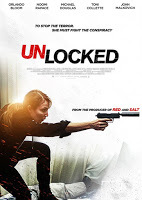 If O'Brien is a newcomer then the film's director Michael Apted is an old hand. His many credits in a long and distingushed career include a Bond film, The World is Not Enough.
If O'Brien is a newcomer then the film's director Michael Apted is an old hand. His many credits in a long and distingushed career include a Bond film, The World is Not Enough.Unlocked is gripping, suspenseful and it kept me guessing. I was pleasurably surprised more than once by sudden twists in the plot.
The only real flaw it has is in following a very hoary cliché. Cynical viewers would guess from the beginning that the heroine's black friend is marked for death.
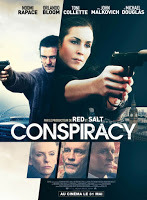 As soon as we see his happy home life, and watch him playing with his beloved infant daughter, we know his fate is sealed...
As soon as we see his happy home life, and watch him playing with his beloved infant daughter, we know his fate is sealed...Other than that, though, full marks for a great script. Well researched, fast moving and very hard-edged. In its ruthlessness it reminded me a little of the spy thrillers by Trevanian like The Eiger Sanction.
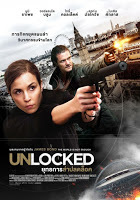 Unlocked has a particularly spectacular cast. Noomi Rapace is perfect in the lead role, but the support includes Michael Douglas and John Malkovich as CIA chiefs, Toni Collette as a senior British spook and, best of all, Orlando Bloom as an ex-soldier turned burglar.
Unlocked has a particularly spectacular cast. Noomi Rapace is perfect in the lead role, but the support includes Michael Douglas and John Malkovich as CIA chiefs, Toni Collette as a senior British spook and, best of all, Orlando Bloom as an ex-soldier turned burglar.For years I had a theory that Bloom was only viable in movies where he could swordfight with the bad guys. Here he proves me comprehensively wrong. He's achieved a new maturity and seriousness.
Unlocked is a first rate action movie. Don't miss it.
(Image credits: The posters are from good old Imp Awards.)
Published on June 11, 2017 02:00
June 4, 2017
"There is So Much Here that Doesn't Make Sense." Alien: Covenant
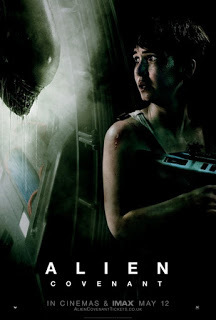 I did not have high hopes for Alien: Covenant. It's a sequel to the Alien prequel Prometheus, and Prometheus is a film which, to put it mildly, I hold in low esteem.
I did not have high hopes for Alien: Covenant. It's a sequel to the Alien prequel Prometheus, and Prometheus is a film which, to put it mildly, I hold in low esteem. Some of my best friends thought Prometheus was a great movie. Personally, I thought it was Plan 9 from Outer Space with a large budget. And some Erich von Däniken gibberish thrown in.
But Prometheus's really fatal error was including a clip from Lawrence of Arabia, thereby reminding us of what a real film, indeed a masterpiece, looked like. In a way, Alien: Covenant makes an even more devastating mistake.
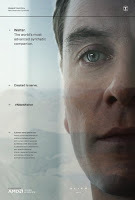 In a sequence where the spunky heroine (Katherine Waterston as Daniels) jams a nail into the evil android's face, as he attacks her, the evil android jovially comments, "That's the spirit!"
In a sequence where the spunky heroine (Katherine Waterston as Daniels) jams a nail into the evil android's face, as he attacks her, the evil android jovially comments, "That's the spirit!"This is of course a quote from Blade Runner. In which Roy Batty, the evil android played by Rutger Hauer says exactly the same thing to Harrison Ford's cop during a similar battle.
Whatever possessed Ridley Scott to allow this? Because, again, we're are reminded of how much better that earlier film was than the one at hand.
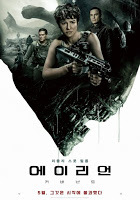
And, in this case, they're both Ridley Scott films.
The evil android in Alien: Covenant is played by Michael Fassbender, and my heart sank when he appeared. Because, although Fassbender is a tremendous actor, that damned android was pretty much the worst thing in Prometheus. And here he is again.
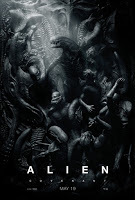 But Fassbender's android is far from the worst thing in Alien: Covenant. The worst thing in Alien: Covenant is the behaviour of the space crew. They land on an alien planet and, just because there's an Earth-like atmosphere, they dispense with space suits and biohazard gear.
But Fassbender's android is far from the worst thing in Alien: Covenant. The worst thing in Alien: Covenant is the behaviour of the space crew. They land on an alien planet and, just because there's an Earth-like atmosphere, they dispense with space suits and biohazard gear.Why would they use such stuff? Because there is the danger of being infected, for example, by some lethal spores that are going to put vicious alien parasites in your body. Which is indeed exactly what promptly happens to two of the landing party.
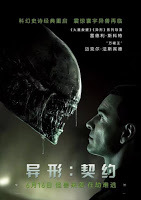 When one of these chumps begins to develop symptoms of a dramatic infection, the pilot of the landing craft very sensibly locks him in isolation in the medical bay. But when the symptoms intensify to full chest-burster status, what does she do? She unlocks the door and charges in with a shotgun...
When one of these chumps begins to develop symptoms of a dramatic infection, the pilot of the landing craft very sensibly locks him in isolation in the medical bay. But when the symptoms intensify to full chest-burster status, what does she do? She unlocks the door and charges in with a shotgun...The results are not happy.
In their utter disregard for contamination protocols, and indeed just plain lack of common sense, the protagonists of Alien: Covenant are eerily similar to the characters in the recent SF/horror movie Life.
But scientists and technicians simply don't behave like this. And when you make the heroes of your movie do so, you lose all sense of reality and any sympathy the audience might have for those characters.
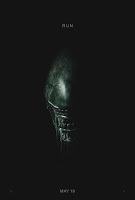 There are many things wrong with Alien: Covenant, but this is the worst. Its protagonists are so utterly stupid that, to be blunt, they deserve to die.
There are many things wrong with Alien: Covenant, but this is the worst. Its protagonists are so utterly stupid that, to be blunt, they deserve to die.Alien Covenant is vastly better than Prometheus. But it is still really, really bad.
(Image credits: The posters are all from Imp Awards. The one which simply says "Run" actually offers useful advice to the prospective viewer.)
Published on June 04, 2017 02:00
May 28, 2017
The Nerve-End Night: All These Condemned by John D. MacDonald
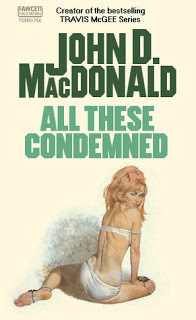 In some previous posts I've suggested that the crime novelist John D. MacDonald really began to hit his stride around the early 1960s. So it's salutary to read this small masterpiece, published in 1954, and discover not only that MacDonald is really cooking, but that he's already at the top of his game.
In some previous posts I've suggested that the crime novelist John D. MacDonald really began to hit his stride around the early 1960s. So it's salutary to read this small masterpiece, published in 1954, and discover not only that MacDonald is really cooking, but that he's already at the top of his game. Over the next few decades he would develop further in scope and depth, and perhaps pare down his story-telling technique, but his writing genius is already on display here, intact and complete. In fact, he's scarily good.
The title All These Condemned is taken from a quotation by Juvenal, from his 12th satire. Later MacDonald cheerfully confessed to faking this — there are only 10 satires by Juvenal. It is a multi-viewpoint novel, something of a speciality for the author.
It is a splintered collection of first person narratives with an ingenious, neat symmetry. The characters are all wonderfully evoked — and impressively diverse. Two chapters are devoted to each, one chapter before and one after...
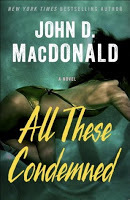 Before and after what? I hear you ask. The death of Wilma Ferris. Wilma is a ruthless tycoon. She has built an empire selling cosmetic products and she is a tough cookie, with "all the vulnerability of a meat axe." Each of the people in the book is dependent on Wilma in some way or other — financially or emotionally. Sometimes both.
Before and after what? I hear you ask. The death of Wilma Ferris. Wilma is a ruthless tycoon. She has built an empire selling cosmetic products and she is a tough cookie, with "all the vulnerability of a meat axe." Each of the people in the book is dependent on Wilma in some way or other — financially or emotionally. Sometimes both. All of them have been invited out to a weekend party in Wilma's cabin — it's actually more like a mansion in the woods — beside a lake. The book begins with the local authorities dragging the lake for Wilma's body. The small boats with their outboard motors are "rattling their tin thunder off the dawn mountains," using "grappling irons and hooks, looking like medieval torments."
Wilma's body is soon found, and we learn that her death is not an accidental drowning but murder. And we're off the to races.
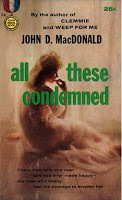 MacDonald is sympathetic and scrupulous in the painstaking way he fleshes out his characters — even stupid little Mavis Dockerty (nee Mary Gort), who is besotted with Wilma, and easily manipulated by her. Mavis is brilliantly evoked, with MacDonald effortlessly slipping into her skin...
MacDonald is sympathetic and scrupulous in the painstaking way he fleshes out his characters — even stupid little Mavis Dockerty (nee Mary Gort), who is besotted with Wilma, and easily manipulated by her. Mavis is brilliantly evoked, with MacDonald effortlessly slipping into her skin...Mavis says things like "I would have been mortified to death" and "chew my nails right down to the hilt." She thinks her poor, hardworking husband has "got about as much romance as a toad in the grass." Wilma Ferris is using her as a weapon against her husband, but Mavis is too dim to see this.
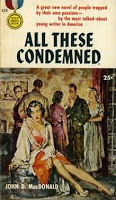 Instead she hero-worships Wilma. Since they met she feels her life, "had kind of opened up. Like going down an alley for a long time and then coming out into a park." Indeed, although Mavis can't or won't see it, she has a powerful sexual crush on Wilma.
Instead she hero-worships Wilma. Since they met she feels her life, "had kind of opened up. Like going down an alley for a long time and then coming out into a park." Indeed, although Mavis can't or won't see it, she has a powerful sexual crush on Wilma.There is also the snobbish, inhibited Wallace Dorn, wearing "the disapproving expression of a master of hounds who has just seen a farmer shoot the fox." Or Randy Hess, Wilma's milksop of a financial advisor, who has made the fatal mistake of having an affair with his boss. He knows the weekend is going to be a catastrophe: "I undressed and lay in the darkness, feeling as if my nerves had poked out through my skin, waving in the night, sampling all the emotions that moved through the big house."
(It's passages like this which remind us that MacDonald was also a distinctive and able writer of science fiction.)
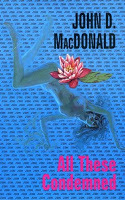 Then there's poor Paul Dockerty, husband of the dimwitted, besotted Mavis, who reflects on love: "it wasn't supposed to go away, like throwing away the pumpkins after Halloween." His view of Wilma Ferris is that "You've got to admire her. But sort of the way you admire a parade going by."
Then there's poor Paul Dockerty, husband of the dimwitted, besotted Mavis, who reflects on love: "it wasn't supposed to go away, like throwing away the pumpkins after Halloween." His view of Wilma Ferris is that "You've got to admire her. But sort of the way you admire a parade going by."MacDonald was really flying when he did this book. He writes of the "dainty and absent-minded finesse" with which a preying mantis devours its mate; the "ponderous morality" of a dullard of a state trooper. Or how the obsequious Randy Hess has "the manner of a dog that... has made a mess on the rug and seeks to avoid punishment with hectic affability."
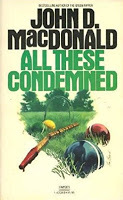 And then there's the virtuosic throw-away gags. Wilma "drives like a banshee with her hair on fire." The dance routine in a Hollywood musical has "sharp-shouldered chorus boys and a quarter ton of bare thighs." A cartoon safe falls out of a window on a cartoon passerby with "damp finality."
And then there's the virtuosic throw-away gags. Wilma "drives like a banshee with her hair on fire." The dance routine in a Hollywood musical has "sharp-shouldered chorus boys and a quarter ton of bare thighs." A cartoon safe falls out of a window on a cartoon passerby with "damp finality." Of course I won't give any hint of who the murderer turns out to be, but I will say the culprit is a Thomas Harris-style psychopath undergoing a "trial of strength" who talks of the killing as a "precise ritual". (Regular readers will know about my cherished theory that Harris is a big John D. MacDonald fan.) On the other hand, the juxtaposition of art and psychopathy is pure Charles Willeford.
But MacDonald really is in a league of his own, way above competitors or emulators. And this is a splendid, outstanding book.
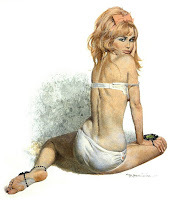 I don't think it needed the last chapter, though, with the good honest simple country cop (state trooper, actually — he of the ponderous morality). It spoils the symmetry (I'm starting to sound like the psychopath now!) and it reduces the quality of the book. But I sense the imposition of a banal editorial mind in this.
I don't think it needed the last chapter, though, with the good honest simple country cop (state trooper, actually — he of the ponderous morality). It spoils the symmetry (I'm starting to sound like the psychopath now!) and it reduces the quality of the book. But I sense the imposition of a banal editorial mind in this.The penultimate chapter, what I think of as the real last chapter, is a striking anticipation of Robert Bloch's Psycho with the killer finally retreating unreachably into their own mind. Maybe the world, or at least America, wasn't ready for an ending like this yet.
(I'd like to acknowledge Steve Scott's excellent John D. MacDonald blog The Trap of Solid Gold, which provided some valuable information. Image credits: the book cover art is from Good Reads, except for the 25 cent photographic cover and the early Gold Medal with a painting by James Meese, also 25 cents, which are from Lesbian Fun World, where the book has quite a profile, and the croquet balls cover, by William Schmidt, which is from Amazon and gives away the murder weapon. The stunning Robert McGinnis cover painting sans text is from Pinterest.)
Published on May 28, 2017 02:00
May 21, 2017
The Vinyl Detective on Audio Books
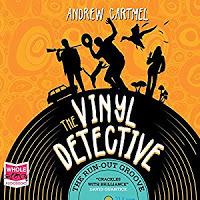 Not long ago I caught a train to the English Midlands city of Leicester. There waiting for me was my friend Alan Ross.
Not long ago I caught a train to the English Midlands city of Leicester. There waiting for me was my friend Alan Ross. I hopped into his van and we set off, leaving the city behind and speeding for the countryside.
Alan's van has a rather nice picture of John Coltrane on it. This is partly because, like me, Alan is a jazz nut.
But, much more importantly, it's because he runs a superb record store in Leicester — Jazz House Records. It was an appropriate vehicle, because our mission today was very definitely vinyl related.
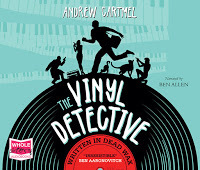
We drove down winding sun-splashed country roads under the green canopies of trees until we reached a small village called Syston.
Here we parked outside a pair of tall white buildings — sort of overgrown cottages — with a kind of Moorish courtyard between them. This was the headquarters of White House Sound.
 After being greeted at reception we were led through a series of large rooms where men and women sat at desks, listening on headphones as they read through large stacks of print out. On each desk was a wooden spindle running through the central holes of a stack of silver discs — CDs.
After being greeted at reception we were led through a series of large rooms where men and women sat at desks, listening on headphones as they read through large stacks of print out. On each desk was a wooden spindle running through the central holes of a stack of silver discs — CDs.Down carpeted corridors we went to a small room packed with recording gear and computer screens, attended by an affable sound engineer. In an adjoining booth a large window allowed us to see walls covered with acoustic-baffle foam panels, a hanging microphone, and a dedicated actor intently reading the words of my novel.
 All the words of my novel. W.F. Howes, the company that is doing the Vinyl Detective audio books, prides itself on recording unabridged versions. In fact, they go under the name Whole Story Audio Books.
All the words of my novel. W.F. Howes, the company that is doing the Vinyl Detective audio books, prides itself on recording unabridged versions. In fact, they go under the name Whole Story Audio Books.That's what those men and women were doing with their headphones — those stacks of paper were the entire text of the books which had been recorded. They were diligently checking that every single word had been accurately captured.
I'm a lucky fellow to have my Vinyl Detective novels being produced by these guys. The first one, Written in Dead Wax was narrated by Ben Allen, the second, The Run-Out Groove has just been completed with Finlay Robertson doing the narration. Ben was a terrific choice, Finlay better still.
 Written in Dead Wax on audio is available here in the UK and here in the US. The Run Out Groove will be unleashed on the world in ten days time, available here and here.
Written in Dead Wax on audio is available here in the UK and here in the US. The Run Out Groove will be unleashed on the world in ten days time, available here and here.Thank you for listening.
(Image credits: The CD covers for the audio books are from Whole Story Audio Books for Written in Dead Wax, and Amazon for The Run Out Groove. The shots of White House Sound are from their website. The pic of Alan and his trusty van is by me.)
Published on May 21, 2017 03:11
May 14, 2017
The Run-Out Groove by Andrew Cartmel
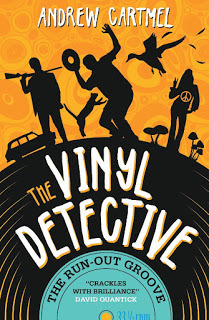 This week saw publication of my second Vinyl Detective novel, The Run-Out Groove. Normally I would have been far too modest to blog about it, but my friend, who just happens to be a bestselling novelist, insisted I should. So, since he knows his stuff.
This week saw publication of my second Vinyl Detective novel, The Run-Out Groove. Normally I would have been far too modest to blog about it, but my friend, who just happens to be a bestselling novelist, insisted I should. So, since he knows his stuff.In case you haven't read my first book, this series follows the adventures of a record collector turned sleuth. (And be warned, this post contains spoilers about Written in Dead Wax.) If you have read the first one, there are a couple of differences this time around...
 For a start, the previous adventure recounted the search for a rare jazz record, so it was immersed in that particular musical world. This time around it's rock music, in particular the British psychedelic or "prog" (for progressive) rock of the 1960s.
For a start, the previous adventure recounted the search for a rare jazz record, so it was immersed in that particular musical world. This time around it's rock music, in particular the British psychedelic or "prog" (for progressive) rock of the 1960s.In fact, when I began working on The Run-Out Groove I had a very specific inspiration in mind from that scene. The brilliant and ill-fated Syd Barrett, a founder member of Pink Floyd. Barrett was a fascinating and tragic figure and I knew this was potentially powerful material.
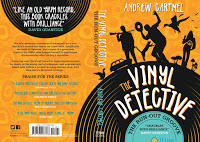 So I reached for the biography of Syd Barrett I'd had knocking around the house for several years... and realised I'd donated it to a charity shop just the previous week. Ah well.
So I reached for the biography of Syd Barrett I'd had knocking around the house for several years... and realised I'd donated it to a charity shop just the previous week. Ah well.This was no bad thing. The notion of a musical genius who became an acid casualty was all I really needed. It was enough of a seed for that element of the story.
But the really big difference between The Run-Out Groove and Written in Dead Wax is that Nevada, the fun loving femme fatale from the first book, has now moved in with our hero and they are an item.
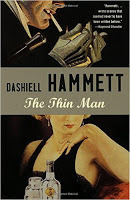 Was this a risk? Changing the Vinyl Detective from an archetypical loner shamus to half of a detective duo? Not really, I knew this could work because I was following in the footsteps of giants. Specifically the footsteps of the wonderful Dashiell Hammett.
Was this a risk? Changing the Vinyl Detective from an archetypical loner shamus to half of a detective duo? Not really, I knew this could work because I was following in the footsteps of giants. Specifically the footsteps of the wonderful Dashiell Hammett.Hammett was one of the greatest crime novelists of them all. And among his finest creations are the urbane Nick and Nora Charles, a husband and wife mystery-solving team. They featured in Hammett's 1934 novel The Thin Man and thereafter in an enduring and wildly popular series of movies.
Let's hope the Vinyl Detective and Nevada have some of that longevity and durability...
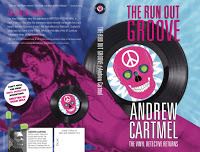 Oh, and since my friend is insisting I promote my new book, you can buy it here if you're in the USA, or here if you're in the UK.
Oh, and since my friend is insisting I promote my new book, you can buy it here if you're in the USA, or here if you're in the UK. Or, indeed, if you'd like a signed copy, leave a message for me in the comment section of this post and we'll see if we can work something out.
Happy reading.
(Image credits: The rather lovely and elegant Thin Man cover is from a little known internet book seller called Amazon. All the other images are from my own collection. The gorgeously gaudy pink and blue creations were commissioned by me from a very talented designer called James King before I got my book deal with Titan, and was toying with the idea of self-publishing.)
Published on May 14, 2017 02:54
May 7, 2017
Elle by Verhoeven, Birke & Dijan
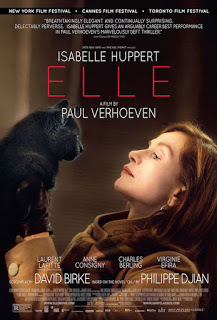 Paul Verhoven’s latest movie is a very strange affair. I like Verhoven's work a great deal. Indeed, to my mind, he is one of our greatest living directors.
Paul Verhoven’s latest movie is a very strange affair. I like Verhoven's work a great deal. Indeed, to my mind, he is one of our greatest living directors. It's a great shame that his career stalled with Showgirls, a film that could have been a hit if only he and his screenwriter Joe Eszterhas — one of the most talented writers in the industry — had bothered to make us care about their characters.
But they didn't, and Showgirls pretty much put paid to their careers, at least in America. After some years of decline, both men found work in European films, though Verhoeven has very much had the best of it, with his excellent World War 2 drama Black Book (2006).
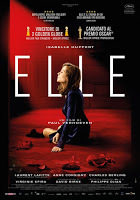 Now Verhoven is back with a film made in France called Elle. It is written for the screen by the American David Birke, based on the novel by Philippe Dijan — who also wrote the book on which Betty Blue was based.
Now Verhoven is back with a film made in France called Elle. It is written for the screen by the American David Birke, based on the novel by Philippe Dijan — who also wrote the book on which Betty Blue was based.As I said, Elle is a curious item. I have become used to defending Verhoven against the critical establishment who loathe his mainstream films like Basic Instinct, Robocop (masterpieces), Total Recall (a near masterpiece masterpiece) and Starship Troopers (hilarious and audacious).
Now I find that the critical establishment is embracing Verhoven and celebrating him for a film which I loathe. The situation is almost surreal. But I went to see my Elle anticipating that it would be something terrific, and it was a staggering disappointment.
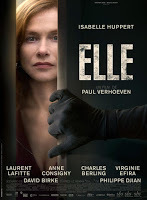 The film is being touted as an Hitchcockian thriller but really it’s a badly judged black comedy with a heavy line in sexual violence. It’s dull, it’s pointless, and it goes on forever. I felt ashamed of myself for wasting my time in a darkened cinema. And it was a beautiful day, too…
The film is being touted as an Hitchcockian thriller but really it’s a badly judged black comedy with a heavy line in sexual violence. It’s dull, it’s pointless, and it goes on forever. I felt ashamed of myself for wasting my time in a darkened cinema. And it was a beautiful day, too… There is a really lovely grey cat in it, though, called Marty. But even Marty can’t rescue this.
(Image credits: Imp Awards.)
Published on May 07, 2017 02:00



